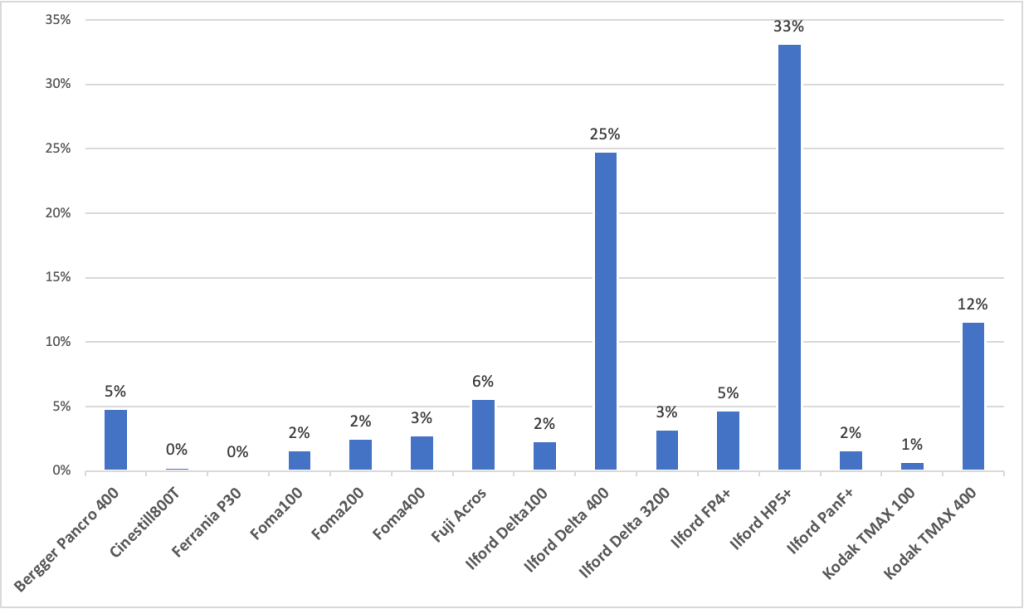The title is a bit exaggerated as I did not reach one thousand rolls developed by me (still a couple of dozens) yet I felt it was time to take some numbers and do some analysis (all in all that is what I do for a living). Even though I’ve been playing with film photography since 2007-2008 (not to mention the fact that I’ve used film cameras as a teenager), it was only around 2013 that I stopped sending my film to a lab and decided to play with chemicals.
This post (which is boring in many ways) is just a recap of what I’ve been doing and what I’ve been drawn to…most of the times based on my artistic preferences, sometimes given the crazy price that some brands are asking these days (Kodak, Fuji…I’m talking to you!).
First things first…what do I usually shoot?
It should not be a surprise that Ilford takes the lead. There are many reasons for that: this company has a true longlasting love for the film community and has managed to keep its offering quite consistent and with a reasinable price given the high standards. At the very beginning I used to pick HP5+ as a cheap option to its main alternative TriX but with time I came to realise how perfect this film is in many ways. Very versatile, you can pull it at 200 or push it at 3200 iso, develop it in XTOL or Rodinal…the results are always fantastic. It is true that it might not have the most beautiful look but there is a reason why when I have to choose, one time out of three I pick it up.
The second most used option is another Ilford film, Delta 400. Technically speaking it is far superior to the Plus series (Tabular grain vs Cubic grain) and in some cases it really shines. The look is not too cynical (as you might get with Tmax400) and the contrast is fantastic when pushed at 800 iso.
When you don’t see in the graph is why I did not shoot more of some other options…I would love to go back and use TriX (there is indeed something magic) as well as Fuji Acros 100 (in terms of beauty of tones and grain I believe the best of them all), but I can’t justify paying 2x or 3x the price of other brands. You might be fooled by the numbers of Tmax400…most of those rolls are in 35mm where I simply believe there is nothing as good as that film.
The moment all techies have been waiting for: the cameras
It is true that the photo is made by the photographer…and the look is made by the film…yet I believe the tool used is important as well. Not necessarily on the final quality, as even though there are differences between the glass of a Zeiss glass for 6×6 and a Nikkor for 35mm, this is less important than you might think. On the other hand I realise that I take different pictures with different cameras, hence the choice is not completely useless.
Again no surprise here, Hasselblad V-series cameras are the ones I would choose should I have to go to a desert island. I started with the 500CM and eventually moved to a 501CM to leverage the Acute Matte screen and better focus (I’m indeed getting older). The sound of a rewind crank is one of the sexiest sound you can hear and composing on the ground glass is pure joy (although there are better options like the screen of a Mamiya RZ67).
Recently I’ve been enjoying also the 6×7 format, especially for portrait and with vertical orientation. The Pentax 67 is not a fantastic camera but its 105mm f2.4 is probably the best lens out there. Too bad it is quite complicated to focus perfectly (that’s why the Mamiya RZ67 is reducing the gap quite quickly), I still love the combo.
In 35mm the FM2n is a pure joy to use, and while the results are often not as good as I expect (I know, being used to medium format my standards are quite high) I tend to use it quite frequently especially when traveling.
How to cook all these?
I admit I did not experiment that much when it comes to developers choice. I started with Ilford DD-X but while it was really great, I quickly abandoned it given the high price per roll. I tend to use XTOL (roughly 50% of the time) and D76 (roughly 25% of the time) almost exclusively: the first is without any doubt the best overall developer as it is cheap, extremely easy to mix, quite environment-friendly and gives excellent results with all films (expect Bergger Pancro 400 where don’t know why but D76 is way better). When I’m in the mood, I also enjoy Rodinal, especially in stand development.
Final thoughts
Well…not sure what to take from all of this? Developing film is tedious, slow, un-efficient…yet I kind of like the wait and the mechanical process…and that’s why I think I’ll keep doing it for a long time.

























